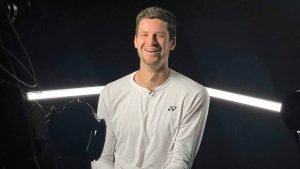

Hurkacz’s ‘Iron Man’ Effort: The Remarkable Return from Meniscus Surgery in Just Three Weeks
In the high-stakes world of professional tennis, where players routinely push their physical limits to secure victories, Hubert Hurkacz’s recent feat stands out as nothing short of extraordinary. Known for his powerful serve and athleticism, Hurkacz has captured the tennis world’s attention not just for his on-court prowess but for his astonishing recovery from a meniscus surgery in just three weeks—an effort that seems almost ‘Iron Man’-like in its audacity and success.
The Road to Recovery
Meniscus surgery, particularly in the context of professional sports, is typically a lengthy and arduous process. The meniscus is a crucial cartilage in the knee that acts as a cushion between the femur and tibia. Damage to this cartilage, whether through acute injury or degenerative changes, often necessitates surgical intervention. Recovery times can vary, but athletes are generally expected to undergo a rehabilitation period that spans several months.
For Hurkacz, however, the usual timeline was dramatically compressed. His decision to undertake an accelerated recovery plan was both bold and risky, but it reflected his determination and exceptional physical condition. Following the surgery, the initial prognosis suggested a return timeline of several months. Yet, Hurkacz’s return to competitive play in just three weeks has been described as nothing short of a miracle by sports analysts and fans alike.
The ‘Iron Man’ Approach
Hurkacz’s recovery strategy was marked by several key elements that combined to produce this remarkable outcome. Central to his approach was an intensive and meticulously planned rehabilitation program. His team of medical professionals, including renowned physiotherapists and sports doctors, tailored a regimen designed to optimize recovery while minimizing the risk of re-injury.
1. Personalized Rehabilitation Protocol
The personalized rehabilitation protocol employed by Hurkacz involved several phases:
- Immediate Post-Surgery Care: Right after the surgery, Hurkacz focused on reducing inflammation and managing pain. This phase included cryotherapy, anti-inflammatory medications, and limited mobility exercises.
- Strength and Flexibility Training: Once the initial healing was underway, Hurkacz began a series of exercises aimed at restoring strength and flexibility to the affected knee. This phase was crucial for rebuilding muscle strength around the knee joint to support the healing meniscus.
- Gradual Return to Activity: As pain and swelling subsided, Hurkacz slowly reintroduced more dynamic activities, including light jogging and agility drills. This step was critical for ensuring that the knee could handle the stresses of competitive play.
2. Cutting-Edge Technologies
Hurkacz’s recovery was bolstered by the use of cutting-edge technologies. He utilized advanced modalities such as:
- Cryo Chambers: These help in reducing inflammation and accelerating muscle recovery by exposing the body to extremely cold temperatures.
- Hydrotherapy: Underwater exercises helped reduce stress on the knee joint while allowing Hurkacz to engage in cardiovascular and strength training.
- Electrotherapy: Techniques like TENS (Transcutaneous Electrical Nerve Stimulation) provided pain relief and facilitated muscle recovery.
3. Mental Resilience and Psychological Support
An often-overlooked aspect of recovery is the psychological component. For athletes like Hurkacz, maintaining a positive mindset and mental resilience is as crucial as physical rehabilitation. He worked closely with sports psychologists to stay focused and motivated throughout the process. Visualization techniques and mental conditioning helped him prepare for the challenges of a return to high-level competition.
The Comeback: A Triumph Against the Odds
Hurkacz’s return to the ATP tour was nothing short of spectacular. Upon resuming play, he quickly demonstrated that he had not only returned to his previous form but had also sharpened his competitive edge. His performance in subsequent matches was characterized by remarkable agility and power, a testament to the effectiveness of his rehabilitation and training.
The decision to return to play so soon after surgery sparked considerable debate among fans and experts. Some lauded his courage and determination, while others questioned the long-term implications of such a rapid recovery. Nonetheless, Hurkacz’s successful return has added a new dimension to his career, showcasing not only his athletic skill but also his resilience and commitment.
The Impact on the Tennis World
Hurkacz’s achievement has broad implications for the world of professional sports. It challenges conventional wisdom about recovery times and highlights the potential of modern sports medicine and rehabilitation techniques. His case may inspire other athletes facing similar challenges to explore accelerated recovery options, albeit with a thorough understanding of the risks involved.
Moreover, Hurkacz’s story underscores the importance of a holistic approach to rehabilitation—one that combines physical therapy, technological advancements, and psychological support. It also serves as a reminder of the extraordinary lengths to which elite athletes will go to return to their sport and compete at the highest level.
Conclusion
Hubert Hurkacz’s ‘Iron Man’ effort to return from meniscus surgery in just three weeks is a remarkable example of modern sports science and human determination. His journey from surgery to competitive play has captivated the tennis world, offering insights into the evolving landscape of athletic recovery. As Hurkacz continues to build on his success, his story will likely serve as an inspiration to athletes across various sports, demonstrating that with the right combination of expertise, technology, and perseverance, even the most daunting challenges can be overcome.
Leave a Reply